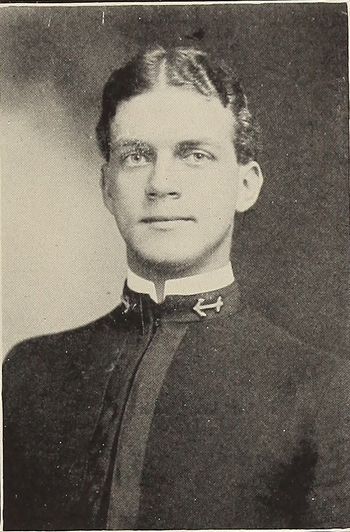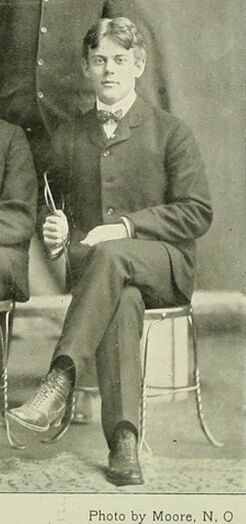HUGH K. AIKEN, ENS, USN
Hugh Aiken '06
Lucky Bag
From the 1906 Lucky Bag:
Hugh Kerr Aiken
New Orleans, Louisiana
"Padre"
Recovered from an operation in the U. S. N. A. hospital! A strong man with a rare capacity for food and sleep. While caressing his wife "Delia" broke her nose in three places. Our ideal of a dashing midshipman—dashing to formation in a race with the bugle.* When really happy plays funeral dirges on his fiddle, and has been known to break forth in to melodies of the Sunny South. A divine dancer with a sister in every port and an extensive grease in old Annapolis. Roomed with "Buoy" for three years without accumulating his exact habits. "You scoundrel!"
Aiken—late breakfast formation—Aiken.
Same—late dinner formation—Aiken.
*The bugle usually wins.
Battalion adjutant; Football (4); Yellow N; Cass Ring Committee; Track Team; Choir Gym Team, Fusser.

Hugh Kerr Aiken
New Orleans, Louisiana
"Padre"
Recovered from an operation in the U. S. N. A. hospital! A strong man with a rare capacity for food and sleep. While caressing his wife "Delia" broke her nose in three places. Our ideal of a dashing midshipman—dashing to formation in a race with the bugle.* When really happy plays funeral dirges on his fiddle, and has been known to break forth in to melodies of the Sunny South. A divine dancer with a sister in every port and an extensive grease in old Annapolis. Roomed with "Buoy" for three years without accumulating his exact habits. "You scoundrel!"
Aiken—late breakfast formation—Aiken.
Same—late dinner formation—Aiken.
*The bugle usually wins.
Battalion adjutant; Football (4); Yellow N; Cass Ring Committee; Track Team; Choir Gym Team, Fusser.
Loss
Hugh was lost on July 11, 1909 when there was a fire aboard one of the coal bunkers aboard USS North Carolina (Armored Cruiser No. 12).
Other Information
From Find A Grave:
FROM THE USNA CLASS OF 1906 45TH REUNION BOOK:
Born October [sic], 1884, New Orleans, Louisiana. Appointed from Louisiana. "Padre" was a man of great charm and dignity. He had a firm but very tolerant disposition and was among the most popular men in the Class. His fine physique made him a natural athlete. He came very near to death after being kicked in the head during an intercollegiate football game. After graduation he was attached to the USS North Carolina, and was promoted to the rank of Ensign. It is a coincidence that another accident cost him his life. He was killed by an explosion of fire damp, in a coal bunker of the North Carolina, while coaling ship on 11 July, 1909 [Aiken went under deck ahead of his men to investigate an accumulation of fumes generated by the stored coal]. He is buried in his home town of New Orleans (Metairie Cemetery). The Aiken School, well known in New Orleans, is directed by Padre's sister Edith.
From researcher Kathy Franz:
Hugh attended Boys' High School in New Orleans.
In late December 1899, Hugh, his sister Edith and his brother William Holcombe attended a rehearsal of the comedy “The New System.” The play was written by Mrs. Thomas Edward Davis (pen name Mollie E.), wife of Major Davis, for their adopted daughter Mary Pearl. Among the characters was Captain Nelsonia Perry Dewey Chester of the U. S. navy and Lieutenant Napoleonette Washington Hannibal Hightower of the U. S. army.
For two years, fall 1900 to spring 1902, Hugh was a student at Tulane. Both he and his brother William were members of Sigma Chi – The Alpha Omicron Chapter. They were both in the Junior Germany Club and on the football team. Hugh was enrolled in Scientific Study.
In April 1902, Hugh was appointed to the Naval Academy by Judge Davey. The Baltimore Sun on October 14 reported that “Aiken is probably the find of the year. As a lineman he holds his own well, and as fullback, though a little slow, he hurls his 185 pounds of brawn with such force against the opposing line as to be a fine ground gainer.”
Hugh suffered a concussion and paralysis at the Bucknell-Navy football game on November 15, 1902. He had surgery, and by December 6, he was permitted to walk around the room.
In the December 8 issue of The Times-Democrat, New Orleans, Dr. M. William Keene reported: “When I first saw him three days after the accident, I found that he had been unconscious for a half hour after the accident and ever since then had complained bitterly of headache, which he located always in the forehead. Soon after the accident he began to develop spasms. In six hours and a half after I saw him he had twenty-four of these attacks, all limited to the right arm. There was no fracture of the skull. The only evidence of any injury was a slight bruise at the outer end of the left eyebrow.
“Had I seen this case before 1885 I would have been unable to explain why the spasms were chiefly manifested in the right arm. I would have been justified in inferring that probably the front part of his brain was at the site of the bruise. Had I opened his skull at that point, I would have found a perfectly normal brain and have missed the clot. The young man, therefore, would have died whether his skull had been opened or not.
“In 1902 observe the difference. As a result of knowledge derived from experiments upon animals, in which I have located precisely the center for motion of the right arm, I reached the conclusion that there had been a rupture of a blood vessel within the head and that the situation of the clot should correspond to the 'arm center.' Its position was fixed absolutely as a result of experiments upon animals.
“As soon as the skull was opened at this point the clot was found; the blood was removed and the patient's life was saved.”
On February, 16, 1906, a military ball was given at the Country Club in Birmingham, Alabama, for classmates Hugh, Reuben Lindsay Walker, Albert Shafner Rees, and Robert Cabaniss.
In 1908, Hugh was in charge of a few torpedo boats sailing from Norfolk to Charleston.
In February that year, Hugh, his sister Edith, and brothers Warwick, John and William attended the cotillion for Miss Mary Minor in New Orleans. On September 10, Hugh and others went on a navy tug to Old Point, Virginia, for a dance.
In July 1909, Hugh's ship, the U.S. cruiser North Carolina, was anchored in Smyrna, in Asia Minor. The officers were entertained by boat concerts, and Hugh hosted a dinner party in honor of Miss Patterson of Smyrna, a member of the English colony there.
Hugh's funeral was attended by both American and Italian sailors in the chapel of the arsenal in Naples. His body was then taken aboard the North Carolina, and a salute of three volleys of musketry were fired and flags lowered. Count Agli, aide of the Duke of Aosta, and Admiral Moreno went aboard the North Carolina bearing condolences of the Italian royal family.
Hugh's father was John Gayle Aiken; his mother was Ada Holcombe. His siblings were: Warwick, an Episcopal minister, Ralph Pringle, John Gayle, Charles Bayne, William Holcombe, and Edith Bayne. His grandfather Hugh Kerr Aiken was a colonel who died in the Civil War.
Photographs
Remembrances
From US War Archives:
On the occasion of Pres. Taft's visit to New Orleans, he referred to Lieut. Aiken in the following words: "But as I stand in the presence of a New Orleans audience, as I stand in an academic atmosphere, I cannot refrain from allusion to the heroic death recently met by a young, bright, able man of your community, Lieut. Aiken of the navy. He saw his dangerous duty, and, with his men under him, thoughtful of their safety, he led them into the place of danger, fell and was overcome, and the only thought he had as he was about to meet his death was, as he asked his commanding officer: 'Have I made good?' It is such standards of living and of dying that I think are inculcated not only at West Point and at Annapolis, but in all academic institutions, of which this Tulane is one of the best examples. And I am glad, in the presence of his neighbors--the neighbors of his father and of his mother, as commander-in-chief of the navy, to pay this tribute to his memory."
The following beautiful tribute to this young officer was published: "There are sorrows of such wide significance, that when they come into our midst, the minor chords are struck as by a master musician, and the penetrating pathos of the notes find response in every heart.
We would not draw aside the veil to whom the right belongs to mourn, but we, too, who stand without, are dim-visioned from the mists of sympathy.
We, too, would add a wreath of laurel to the wreaths already there--the 'honor wreaths' for the 'gallant officer and gentleman,' who walked in honor's path, and in his youth, ere life's sun had reached meridional glow, saluted, at last command--received his passport to eternity--and entered into new fields of action, 'where winged souls fly beyond all change, in the eternal distance to perfected life.'
For him, 'all's well.' For those who mourn, 'all's well,' for his life, like a broken column, gleams in unsullied whiteness, unmarred by stains of sin, or rude chisel of dishonor. The honors of country and foreign power have been paid him. The flag at half-mast--the wreath of honor--the pall of the flowers, bedewed by sweet affection. And from the bugle's silver-throat, the long, last, farewell note-the call to rest-for 'all's well'-when 'He giveth His Beloved sleep.'
A wreath of laurel, to the memory, of Ensign Hugh K. Aiken, U. S. N., 'gallant officer and gentleman', who died in his youth." The classmates of Lieut. Aiken have placed a tablet to his memory at Annapolis Naval academy, upon which is inscribed: "In memory of Ensign Hugh Kerr Aiken, U. S. N., who was killed in the performance of duty on board the United States cruiser, North Carolina, in the Bay of Naples, July 11, 1909. 'And so this man died, leaving his death an example of courage, his life a memorial of virtue.' Erected by his class mates of 1906.
The "Register of Commissioned and Warrant Officers of the United States Navy and Marine Corps" was published annually from 1815 through at least the 1970s; it provided rank, command or station, and occasionally billet until the beginning of World War II when command/station was no longer included. Scanned copies were reviewed and data entered from the mid-1840s through 1922, when more-frequent Navy Directories were available.
The Navy Directory was a publication that provided information on the command, billet, and rank of every active and retired naval officer. Single editions have been found online from January 1915 and March 1918, and then from three to six editions per year from 1923 through 1940; the final edition is from April 1941.
The entries in both series of documents are sometimes cryptic and confusing. They are often inconsistent, even within an edition, with the name of commands; this is especially true for aviation squadrons in the 1920s and early 1930s.
Alumni listed at the same command may or may not have had significant interactions; they could have shared a stateroom or workspace, stood many hours of watch together, or, especially at the larger commands, they might not have known each other at all. The information provides the opportunity to draw connections that are otherwise invisible, though, and gives a fuller view of the professional experiences of these alumni in Memorial Hall.
July 1907
January 1908
January 1909
Memorial
Hugh's classmates erected a plaque to his honor in Memorial Hall. It reads in part: "This man died, leaving his death an example of noble courage, his life a memorial of virtue."

The "category" links below lead to lists of related Honorees; use them to explore further the service and sacrifice of alumni in Memorial Hall.
